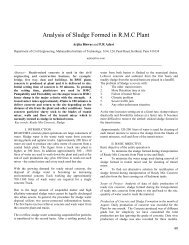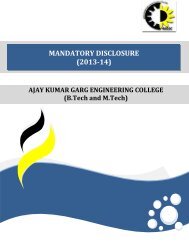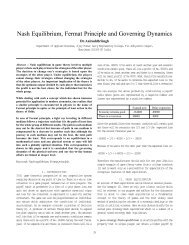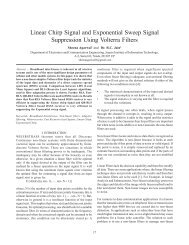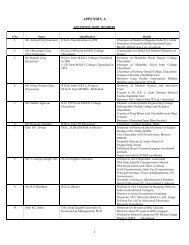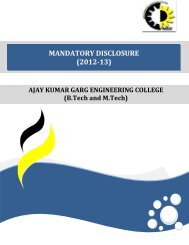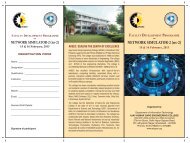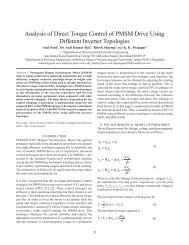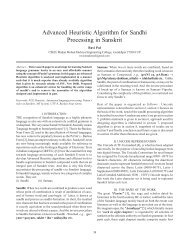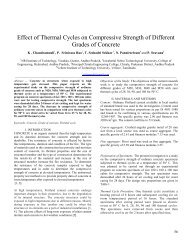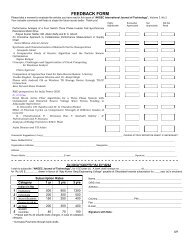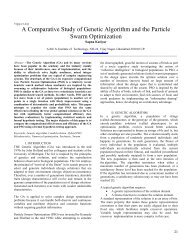Architectural designs and Constructability Issues
Architectural designs and Constructability Issues
Architectural designs and Constructability Issues
You also want an ePaper? Increase the reach of your titles
YUMPU automatically turns print PDFs into web optimized ePapers that Google loves.
AKGEC INTERNATIONAL JOURNAL OF TECHNOLOGY, Vol. 3, No. 1<br />
<strong>Architectural</strong> Designs <strong>and</strong> <strong>Constructability</strong> <strong>Issues</strong><br />
Eng. Ali Akbar Kamari 1 <strong>and</strong> Prof. S. S. Pimplikar 2<br />
1<br />
No 24, Roz Alley, Rohani Ave, Mahdieh St, Hamedan, Iran<br />
2<br />
Department of Civil Engineering, MIT College, Paud Road, Camp, Pune 411038, Maharashtra, India<br />
hamid.kamari@gmail.com, sunil.pimplikar@mitpune.edu.in<br />
Abstract -- Enhancing construction abilities is a primary concern<br />
for designers & builders. This can be examined through a<br />
roughly-tuned concentration on the relationship between<br />
<strong>Architectural</strong> design & constructional issues. According to<br />
constructional issues, effective <strong>designs</strong> will lead to effective<br />
structures as the relationship between these two is considered<br />
synergistic. Nowadays, project teams often perform<br />
constructability reviews to identify problematic issues that limit<br />
constructions performance.<br />
Problematic issues related to architectural <strong>designs</strong> occur mostly<br />
in these areas: Civil, Structural, Mechanical, Electrical against<br />
compatibility with <strong>Architectural</strong> design. Overall analysis of<br />
these areas will lead to a great change in the way things have<br />
been done in the two last decades in <strong>Architectural</strong> realm.<br />
Importantly, the analysis of the potentials to improve<br />
sustainability & the constructability of a project will enhance<br />
when the issue & <strong>designs</strong> are integrated & approached in a<br />
combined fashion.<br />
where the design team evaluates, selects, <strong>and</strong> finalizes the<br />
major systems <strong>and</strong> components of the project.<br />
The design phase also includes the preparation of technical<br />
documents, specifications, as well as the general conditions.<br />
The project schedule <strong>and</strong> budget continue to be developed<br />
<strong>and</strong> monitored during this phase. The project procurement<br />
phase is the time when the project formally transitions from<br />
design preparation into construction preparation. This phase<br />
includes the bidding <strong>and</strong> award process. The project’s schedule<br />
<strong>and</strong> budget are finalized in this phase. The construction phase<br />
presents the actual physical construction of the project. This<br />
phase begins with the mobilization to the site, then the<br />
implementation, <strong>and</strong> finally ends by the project closeout.<br />
This paper assesses constructability practices among designers<br />
with high focus on <strong>Architectural</strong> design. The data is obtained<br />
from theoretical observations as stage 1 (review & search on<br />
previous observations) <strong>and</strong> practical observations as stage 2 (case<br />
study & questionnaire paper).<br />
Keywords: Phases, Types, <strong>Architectural</strong> <strong>designs</strong>, Importance of<br />
<strong>Constructability</strong> <strong>Issues</strong><br />
I. INTRODUCTION<br />
FROM start to completion, construction projects undergo a<br />
number of phases characterized by many tasks aimed at<br />
identifying, planning, designing, <strong>and</strong> constructing the<br />
proposed facility. Such phases <strong>and</strong> tasks may be grouped into<br />
two main stages as shown in Figure 1; a Preconstruction Stage<br />
<strong>and</strong> a Construction Stage.<br />
During the conceptual planning phase, the owner hires key<br />
consultants to begin selecting the project site, <strong>and</strong> developing<br />
a conceptual estimate, plan, <strong>and</strong> program. In this phase, the<br />
owner, after gathering information about the project, makes a<br />
decision whether or not to proceed with the project. The design<br />
development phase comprises of: (1) the schematic <strong>designs</strong><br />
where the design team investigates alternate design solutions<br />
<strong>and</strong> alternate materials <strong>and</strong> systems, <strong>and</strong> (2) the detailed design<br />
Figure 1. Construction project phases [1].<br />
The successful completion of a construction project requires<br />
a thorough underst<strong>and</strong>ing of all stages <strong>and</strong> phases of the<br />
project, <strong>and</strong> can be enhanced through integration of design<br />
<strong>and</strong> construction during the pre-construction stage.<br />
<strong>Constructability</strong>, or buildability, is a major factor in measuring<br />
the success or failure of construction projects. Several<br />
constructability problems or barriers to accomplish a successful<br />
project may be addressed during the pre-construction stage,<br />
as well as the construction stage. During the pre-construction<br />
stage, lack of construction knowledge/experience integration<br />
8
ARCHITECTURAL DESIGN ISSUES<br />
in the planning <strong>and</strong> design processes is a major factor that<br />
leads to constructability problems during the construction<br />
stage. This is because many design professionals have little<br />
experience in construction practices, local considerations, the<br />
availability of different resources, <strong>and</strong> are not necessarily<br />
experts in construction means <strong>and</strong> methods. During the<br />
procurement phase, contractor reliance on contract documents<br />
to visualize the construction process <strong>and</strong> decide on appropriate<br />
construction methods is limited to 2D drawings. This approach<br />
limits the contractor’s ability to be more familiar with the project<br />
at this early stage <strong>and</strong> prior to the start of actual construction.<br />
During the construction stage, constructability issues such<br />
as safety, storage access, security, quality, <strong>and</strong> schedule<br />
updating are major factors that influence the accomplishment<br />
of a successful project.<br />
II. NEED FOR STUDY<br />
Purpose<br />
As projects get more <strong>and</strong> more complex the issue of<br />
constructability becomes important. <strong>Constructability</strong> infiltrates<br />
all parts of a project, especially those related to the engineering<br />
<strong>and</strong> architectural professions. With projects becoming more<br />
<strong>and</strong> more complex <strong>and</strong> time frames shorter <strong>and</strong> shorter, implied<br />
warranty <strong>and</strong> severe professional liability issues may arise.<br />
Design professionals need to be aware of the potential issues<br />
<strong>and</strong> claims implied by a design’s constructability or build ability<br />
profile. When a project has inherent constructability issues,<br />
resulting litigation can involve delay claims, change order<br />
issues <strong>and</strong> disputes, <strong>and</strong> owner’s dissatisfaction with delivery.<br />
In extreme situations, direct claims may be made against the<br />
design principal for poor plans, specifications or estimates, or<br />
schedules that have made the project difficult to build, or more<br />
costly or time consuming than anticipated.<br />
The issue is well recognized in the construction industry, but<br />
what is not so well recognized is when to do constructability<br />
reviews, who should do them <strong>and</strong> how they should be done.<br />
This Practice Note provides suggestions <strong>and</strong> a methodology<br />
for conducting constructability reviews of projects of all types<br />
<strong>and</strong> sizes. <strong>Constructability</strong> issues not only involve issues of<br />
build ability, but also the sequence of construction <strong>and</strong><br />
integration of systems in a logical sequence using st<strong>and</strong>ard<br />
substructures.<br />
There are two purposes for the formation of the collecting of<br />
<strong>Constructability</strong> issues. These include:<br />
• To create an ongoing forum for the definition of a<br />
constructability body of knowledge through the<br />
compilation of case studies related to architectural<br />
<strong>designs</strong><br />
• To provide a case study data set for academic education<br />
in architectural engineering<br />
Features<br />
<strong>Constructability</strong> is a project management technique for<br />
reviewing construction processes from start to finish during<br />
the pre-construction phrase[13]. It will identify obstacles before<br />
a project is actually built to reduce or prevent error, delays <strong>and</strong><br />
cost overruns. The term “constructability” is referred to as:<br />
• The extent to which the design of the building facilitates<br />
ease of construction, subject to the overall requirements<br />
for the completed building[13]<br />
• A system for achieving optimum integration of<br />
construction knowledge <strong>and</strong> experience in planning,<br />
engineering, procurement <strong>and</strong> field operations in the<br />
building process, <strong>and</strong> balancing the various project <strong>and</strong><br />
environmental constraints to achieve overall<br />
objectives[13]<br />
• A system for achieving optimum integration of<br />
construction knowledge in the building process <strong>and</strong><br />
balancing the various project <strong>and</strong> environmental<br />
constraints to maximize achievement of project goals <strong>and</strong><br />
building performance[13]<br />
III. LITERATURE REVIEW<br />
Following points emerged from the literatures review:<br />
1. <strong>Constructability</strong> improvement strategies: Several strategies<br />
<strong>and</strong> concepts have been presented to improve the project<br />
constructability during the different phases of the preconstruction<br />
stage. Tatum recommended the use of the<br />
“backward pass” approach to planning to ensure that the<br />
schedule is driven by the construction needs. Galvanic<br />
described two methods for improving constructability <strong>and</strong><br />
decreasing design-related problems during the construction<br />
process: (1) Design Phase Scheduling, <strong>and</strong> (2) In-House<br />
Design-Phase <strong>Constructability</strong> Review. O’Connor et al<br />
identified seven concepts for improving constructability<br />
during the design/procurement phases of a project: (1) a<br />
Construction-Driven schedule, (2) Simplified Design, (3)<br />
st<strong>and</strong>ardization of design, (4) Pre-assembly work should be<br />
scoped in advance <strong>and</strong> pre-assembly <strong>designs</strong> should be<br />
prepared to facilitate fabrication, transport, <strong>and</strong> installation,<br />
<strong>and</strong> thus to enhance project constructability. (5) Accessibility,<br />
(6) Adverse Weather, (7) Specifications.[1]<br />
2. <strong>Constructability</strong> improvement solution models: Different<br />
solution models for constructability improvement were<br />
implemented to assist the project team in integrating<br />
construction knowledge/experience during the preconstruction<br />
stage. Fischer presented a Construction<br />
Knowledge Expert (COKE) that guides designers towards<br />
designing structures that are more constructible. Patty et al.<br />
presented a computer tool that utilizes a multimedia to give the<br />
designer the capability of accessing constructability<br />
information at the point of design. Moore <strong>and</strong> Tunnicliffe<br />
described aspects of the production of an Automated Design<br />
Aid (ADA) that provides the designer with useful decision<br />
9
AKGEC INTERNATIONAL JOURNAL OF TECHNOLOGY, Vol. 3, No. 1<br />
support regarding design corrections <strong>and</strong> adaptations.<br />
Kupernas et al introduced a methodology to use a computer<br />
aided drafting (CAD) 3D model of a project to review design<br />
layouts <strong>and</strong> to identify design conflicts as part of a preconstruction<br />
constructability review. Within this methodology<br />
two reviews are performed. <strong>Constructability</strong> improvement<br />
solution models as explained in up made by Kupernas has<br />
shown in Figure 2.[1]<br />
Figure 2. <strong>Constructability</strong> improvement solution models[1].<br />
3. The maximum benefits of constructability reviews, measured<br />
by their ability to influence cost, are obtained in the design<br />
phase. Therefore, the study reported here surveys design firms<br />
to assess the current practice of constructability reviews<br />
conducted in the design of buildings <strong>and</strong> engineering works.<br />
The major findings <strong>and</strong> the conclusions of the research are<br />
summarized as follows:<br />
A. Most design professionals are aware of constructability as<br />
a quality indicator of their finished product. About 96% of the<br />
respondents are familiar with the concept of constructability,<br />
B. Slightly more than half of the designers indicated that they<br />
have a documented, formal corporate policy to conduct<br />
constructability reviews in their organization,<br />
C. There is evidence that designers are ab<strong>and</strong>oning the<br />
traditional, physical small-scale models in favor of computer<br />
generated 3D models,<br />
D. Peer reviews <strong>and</strong> feedback systems are the most prevalent<br />
tools used to achieve high levels of constructability,<br />
E. Most designers conduct constructability reviews in both<br />
the preliminary <strong>and</strong> developed design stages.,<br />
F. Design professionals believe that project complexity is an<br />
essential factor that affects the way a constructability review<br />
is conducted in the design stage. Project complexity<br />
technology, materials, <strong>and</strong> methods of construction!<br />
G. Design practices <strong>and</strong> philosophy usually determine the<br />
approach followed in analyzing the constructability of a design,<br />
H. Faulty working drawings <strong>and</strong> incomplete specifications are<br />
the major constraints working against constructability of<br />
design; on the other h<strong>and</strong>, owner resistance <strong>and</strong> budget<br />
limitations are perceived by designers as having a trivial effect<br />
on constructability,<br />
I. Designers consider developing good relationships with<br />
contractors <strong>and</strong> clients <strong>and</strong> avoiding litigation to be the best<br />
rewards of a highly constructible design. This finding supports<br />
the involvement of construction personnel in the design phase,<br />
which presumably improves the mutual underst<strong>and</strong>ing among<br />
the parties involved in the construction project, consequently<br />
reducing the chances for future disputes <strong>and</strong> potential litigation,<br />
J. Value engineering can be a complementary process to<br />
constructability, but cannot replace it [2].<br />
4. Many constructability issues exist that can influence<br />
implementation of constructability reviews on transportation<br />
projects. These issues were identified <strong>and</strong> then categorized<br />
into three areas related to project execution processes, project<br />
planning <strong>and</strong> technical design documents, <strong>and</strong> project<br />
resources. Based on the analysis of issues within each<br />
category, senior management within state transportation<br />
agencies should consider a number of strategies. First, they<br />
must recognize the favorable benefit/ cost ratio of<br />
implementation. Similarly, they should develop an agency<br />
policy specifically for constructability. Next, a process for<br />
incorporating constructability reviews into the planning,<br />
design, <strong>and</strong> construction phases must be implemented. This<br />
process should incorporate the use of a constructability team,<br />
a constructability consultant/ engineer, lessons learned,<br />
alternate contracting approaches, <strong>and</strong> constructability tools.<br />
The process should ensure feedback to designers <strong>and</strong> feedback<br />
from maintenance <strong>and</strong> operations personnel. Ultimately, the<br />
process must enhance plans, specifications, <strong>and</strong> contract<br />
documents for constructability. Managers within state<br />
transportation agencies can focus on these strategies to aid in<br />
the development of a successful constructability program [5].<br />
5. <strong>Constructability</strong> Review Manual: The basic steps to<br />
preparing a <strong>Constructability</strong> review are:<br />
‣ Study the construction documents, read the<br />
specifications, underst<strong>and</strong> the program or design<br />
parameters, the Owner’s needs <strong>and</strong> concerns including<br />
the initial budget. This will allow one underst<strong>and</strong> the<br />
make-up of the project, the critical items, the areas of<br />
concern, <strong>and</strong> possible value engineering issues.<br />
‣ Most Architects should appreciate comments to improve<br />
the quality of the documents. One need to should be<br />
careful not to offend the Architect with comments.<br />
Architects should realize that this review would reduce<br />
the number of Bulletins, design clarifications, RFI’s <strong>and</strong><br />
Contract Administration during construction.<br />
‣ During the <strong>Constructability</strong> Review one should also note<br />
potential scope issues <strong>and</strong> gaps that are discovered in<br />
the detail review <strong>and</strong> collect these by trade to allow the<br />
items to be incorporated into the Additional Provisions.<br />
10
ARCHITECTURAL DESIGN ISSUES<br />
‣ The <strong>Constructability</strong> review session should be planned<br />
<strong>and</strong> organized to produce the best results possible.<br />
Depending on the complexity of the project, there may<br />
be different methods used during the session. Some<br />
methods may include the following:<br />
• Focus review on specific areas of the building, or by<br />
floor.<br />
• Assign certain trades to different people so they can<br />
focus on one type of trade (i.e. door issues, wall types,<br />
ceiling heights, foundation conflicts, roofing details,<br />
etc.).<br />
• Review the building by major discipline, such as structure,<br />
site work, exterior envelope, architectural, mechanical,<br />
electrical, <strong>and</strong> plumbing.<br />
<br />
One must perform a separate review of the building<br />
envelope <strong>and</strong> its details, since this is usually a<br />
source of post-construction problems.<br />
• <strong>Architectural</strong> review should be done so that all portions<br />
of the drawings are completely reviewed, such as floor<br />
plans, interior elevations, ceiling plans, finish schedules,<br />
sections, <strong>and</strong> details [9].<br />
6. <strong>Constructability</strong> Session:<br />
‣ When planning a <strong>Constructability</strong> Review session,<br />
different Consultant’s staff representing all disciplines<br />
of the work should be invited. The review may be divided<br />
into areas or by discipline, i.e. <strong>Architectural</strong>, Structural,<br />
Mechanical, Electrical, etc. <strong>and</strong> include the following<br />
invited attendees:<br />
- Operations Manager (Optional)<br />
- Project Executive<br />
- Project Manager (if assigned)<br />
- Pre-Construction Manager or <strong>Architectural</strong> Estimator<br />
- Mechanical Estimator<br />
- Electrical Estimator<br />
- Project Superintendent (if assigned)<br />
- Project Engineer (if assigned)<br />
‣ An individual with a good grasp of the entire project<br />
should spearhead the review process, <strong>and</strong> act as a<br />
collecting point for comment, suggestions, etc. This team<br />
may provide different areas of expertise <strong>and</strong> a wellrounded<br />
review of the Documents focused on past<br />
experience <strong>and</strong> design coordination.<br />
‣ In most instances, the architect, consultants, <strong>and</strong>/or<br />
owner’s representative should be invited to attend, if<br />
the Project Executive believes that their presence will<br />
facilitate the <strong>Constructability</strong> review session.<br />
‣ Involving other Consultant’s employees not assigned<br />
to the specific project is also helpful, especially if that<br />
individual(s) has experience with a particular building<br />
type, building product, or architect.<br />
‣ In certain situations, where unique or special construction<br />
<strong>and</strong> systems are part of the design, it may be appropriate<br />
to solicit subcontractor <strong>and</strong> vendor input.<br />
‣ The session should be long enough to allow sufficient<br />
time to review all of the documents, which in most cases,<br />
will require at least a whole work day, or more. A list of<br />
responsibilities should be prepared in advance. Try to<br />
arrange for the session to take place in a place where<br />
there will be the least amount of distractions <strong>and</strong> phone<br />
calls for the participants, which are disruptive [9].<br />
7. The sponsor or champion is the driving force behind<br />
constructability reviews on projects by: (1) setting project<br />
objectives, (2) selecting the contract strategy, (3) selecting<br />
which outside consultants or contractors will participate if<br />
needed, <strong>and</strong> (4) funding constructability resources during<br />
planning <strong>and</strong> design [11].<br />
8. (A) Identify <strong>Constructability</strong> Features: The first module<br />
identifies design-relevant constructability problems in the input<br />
IFC-based product model <strong>and</strong> instantiates them as<br />
constructability features. Product features are used extensively<br />
in manufacturing to describe the geometric forms or entities in<br />
a product model that are important in some aspect of the<br />
manufacturing process, (B) Identify Construction Implications:<br />
The second module identifies the construction implications<br />
for the project-specific constructability features. They currently<br />
represent construction implications generically in terms of<br />
activities, resources, <strong>and</strong> resource productivity rates <strong>and</strong><br />
classify constructability features accordingly. Hence, the<br />
system identifies the appropriate construction implication<br />
based on the type of the constructability feature, (C) Calculate<br />
Costs: The third module calculates the costs of constructability<br />
features based on the associated construction implications.<br />
At this stage in the reasoning process, calculating the<br />
construction costs is straightforward because the system<br />
underst<strong>and</strong>s how the constructability features affect activities,<br />
resources, <strong>and</strong> resource productivity rates. The output of the<br />
third module is a set of prioritized project-specific<br />
constructability features <strong>and</strong> their associated costs [3].<br />
IV. OBJECTIVES AND TOOLS OF THE STUDY<br />
In the study, the following objectives are envisaged are fallows:<br />
1) The objective of the research is to accelerate the use of<br />
constructability programs through the identification of<br />
common architectural constructability issues <strong>and</strong><br />
identification of key constructability check strategies in<br />
related with architectural <strong>designs</strong>.<br />
2) Changing industry needs have take big leaps in the past<br />
two decades. Design <strong>and</strong> construction practices <strong>and</strong><br />
project delivery systems have moved into the direction<br />
of integration. This has strongly encouraged many<br />
practitioners to consider design processes <strong>and</strong><br />
construction processes concurrently in consecutive<br />
phases. By narrowing the gap between design <strong>and</strong><br />
construction, thru integration, project constructability<br />
can be greatly improved. This white paper attempts to<br />
11
AKGEC INTERNATIONAL JOURNAL OF TECHNOLOGY, Vol. 3, No. 1<br />
present the author’s views on how the design process<br />
can be further enhanced thru direct integration with the<br />
construction process. The paper first presents a brief<br />
summary of several recent research efforts that address<br />
this issue. The paper then presents a model for integrating<br />
the design <strong>and</strong> construction processes during the preconstruction<br />
stage for improved constructability.<br />
In the study, the following tools are envisaged:<br />
• Collection of data with search in existing observations<br />
<strong>and</strong> studies (Stage 1)<br />
• Collection of data based on actual site observations<br />
(Stage 2)<br />
• Collection of data through a questionnaire paper survey<br />
(Stage 3)<br />
V. METHODOLOGY OF THE STUDY<br />
In order to achieve the objectives set, data was collected from<br />
the field practices which are being followed in the building<br />
construction <strong>and</strong> from the different project sites <strong>and</strong> different<br />
locations, also form the professional consultant companies by<br />
submitting the questionnaires <strong>and</strong> abundant meeting with<br />
engineers who are forefront in the four field of construction,<br />
<strong>Architectural</strong>, Civil, Mechanical, <strong>and</strong> Electrical fields.<br />
The companies from where data is collected are listed below:<br />
• Construction Engineering Sservices(I) Pvt.Ltd<br />
• Vedanta Engineering Consultancy Services<br />
• Nucon Products Pvt.Ltd<br />
• Construction Catalysers Private Limited<br />
The type of data collected for stage 3 is based on the<br />
information presented in questionnaire:<br />
• The questionnaire contains project name, location,<br />
building type, date of completion, type of contract,<br />
etc; A sample questionnaire is presented in<br />
Appendix A.<br />
- An attempt is made to explore some <strong>Constructability</strong><br />
<strong>Issues</strong> which have been experienced by professional<br />
Engineers <strong>and</strong> Architects, during their lifetime<br />
- The information <strong>and</strong> data collected is analysed in order<br />
to achieve the aforementioned objectives based on which<br />
few recommendation are made; in order to improve<br />
constructability.<br />
<strong>Constructability</strong> <strong>Issues</strong> <strong>and</strong> Area of Occurrence: Typical<br />
constructability problems from the following disciplines:<br />
- Structural<br />
- Civil<br />
- Mechanical<br />
- Electrical<br />
- <strong>Architectural</strong><br />
This excerpt from abstruse projects illustrates the sort of<br />
problems that routinely occur “inside” a discipline - in this<br />
case <strong>and</strong> according to the result of first diagram in the area of<br />
Figure 3. <strong>Constructability</strong> <strong>Issues</strong> <strong>and</strong> Area of Occurrence<br />
in related with architectural <strong>designs</strong>.<br />
Civil <strong>and</strong> Structural (Figure 3)- where only someone actively<br />
looking for discrepancies within the disciplines will find them.<br />
As with all similar problems, these (<strong>and</strong> many others so have<br />
discovered) delayed the project for months.<br />
Projects status occasionally were as follows when asked to<br />
review the project:<br />
Majority of field constructions were not building <strong>and</strong><br />
completing projects as expected.<br />
Average of the construction cost were more than Rs 5 million,<br />
with the local relevant financing majority.<br />
Although a routine Interdisciplinary Coordination Review had<br />
been conducted prior to construction, it failed to highlight the<br />
serious problems. What was missing A thorough review of<br />
each discipline.<br />
Figure 4. Rating Contract types with respect to their usage in field<br />
of construction(out of 100 %).<br />
Contract types: The type of contracting is related to volume of<br />
constructability issues(Figure 4), most <strong>and</strong> best usage were<br />
BOT(Build-Operate-Transfer) <strong>and</strong> DB(Design-Build); In<br />
12
ARCHITECTURAL DESIGN ISSUES<br />
general volume of constructability problems were lesser vis as<br />
vis rest(for the mentioned contract types, BOT had minimum<br />
constructability issues against the other types.<br />
<strong>Constructability</strong> <strong>Issues</strong> Into project Phases: The projects<br />
considered had some times over 950 drawings - <strong>and</strong> majority<br />
used the Metric system. The review took five weeks to complete.<br />
An overview of the report follows:<br />
- In geotechnical sector there were populous observed<br />
problems in Detail-Design <strong>and</strong> Construction phases(5.7,<br />
7.2)<br />
Meanwhile as a results, problems suggest itself in Construction<br />
phase majority; All components of course, would depend on<br />
the main area of occurrence but engineers should high focus<br />
<strong>and</strong> also high conciliation in foregoing phase.<br />
Figure 6. Timing of constructability reviews: A, conceptual planning<br />
stage; B, preliminary design stage; C, developed design stage; D,<br />
after finishing the design [2].<br />
Figure 5. <strong>Constructability</strong> <strong>Issues</strong> Into project Phases.<br />
With respect to project phases(Figure 5) volume of<br />
constructability issues in related to each field of construction<br />
are different <strong>and</strong> for each field respect to figure 3 engineers<br />
must focus seriously on the life cycle aspects of the projects<br />
as:<br />
- In architectural sector there were many issues in the<br />
Detail-Design <strong>and</strong> Pre-Concept Planning phases(9.2 , 6.5)<br />
- In civil sector there were many observed problems in<br />
Detail-Design <strong>and</strong> Construction phases(8.6 , 8.9)<br />
- In structural sector there were numerous problems in<br />
Detail-Design <strong>and</strong> Construction phases(8.6 , 7.8)<br />
- In mechanical sector there were high issues in Contract<br />
Award <strong>and</strong> Construction phases(6.7 , 5.2)<br />
- In electrical sector there were many problems in Concept-<br />
Design <strong>and</strong> Detail-Design phases(8.4 , 7.5)<br />
Timing of <strong>Constructability</strong> Reviews: The responses plotted in<br />
figure 6 show that the developed design stage is where most<br />
constructability reviews are conducted (87%). It was also found<br />
that 25% of the respondents perform constructability analysis<br />
throughout the entire design process conceptual planning,<br />
preliminary design, developed design stages, <strong>and</strong> after<br />
finishing the design. This means that one quarter of the design<br />
firms surveyed treats constructability improvement as part of<br />
an overall continuous project improvement process, which is<br />
the recommended practice by most researchers.<br />
It is generally thought that constructability reviews should be<br />
conducted after plans are completed to a certain level in order<br />
for reviewers to have something to work with. An alternative<br />
process emphasizes that construction expertise must be<br />
brought in before any design is put onto paper. This way,<br />
opportunity is provided to the designers to begin their work<br />
with certain key issues in mind, issues that can frequently be<br />
accommodated without adverse cost to the design.[2]<br />
If the sum of the respective bars in figure 6 is considered, it can<br />
be observed that 51% of the firms start performing<br />
constructability reviews as early as the conceptual planning<br />
stage, <strong>and</strong> 80% as early as the preliminary design stage. Four<br />
percent stated that their firms conduct constructability reviews<br />
only after finishing the design. Only one respondent (0.8%)<br />
indicated that his/her firm never performs constructability<br />
reviews. These findings indicate that there is a tendency to<br />
13
AKGEC INTERNATIONAL JOURNAL OF TECHNOLOGY, Vol. 3, No. 1<br />
perform constructability reviews early in the design process in<br />
order to obtain maximum benefits. This finding supports<br />
recommends that the constructability review process must<br />
begin at the earliest conceptual stage to be fully effective.[2]<br />
A constructability review process developed by the<br />
Washington State Department of Transportation (WASHDOT)<br />
is very similar to the practice reported by the respondents.<br />
The WASHDOT process is composed of four constructability<br />
reviews performed at various stages during the course of a<br />
project. The first review is performed at the completion of the<br />
draft project definition report, a comprehensive project report<br />
developed during the project definition stage at which time a<br />
value engineering study is performed. Then successive reviews<br />
are conducted at various points during development of plans,<br />
specifications, <strong>and</strong> estimate [2].<br />
Factors That Enhance <strong>Constructability</strong>: The factors that were<br />
rated in the survey by the designers are all project related. The<br />
factors are plotted in figure 7 according to their mean score,<br />
which ranges from 0 to 90 (0 being the least influential <strong>and</strong> 90<br />
the most influential).<br />
Figure 7. Rate the following factors with respect to their effect on<br />
constructability (A-Project delivery system, B-Project complexity,<br />
C-Project size, D-Design st<strong>and</strong>ards <strong>and</strong> codes,<br />
E-Project location, F-Client type, G-Design practices <strong>and</strong><br />
philosophy, H-After finishing the design).<br />
The most significant factor selected by the respondents is<br />
project complexity, which reinforces the results of the<br />
Construction Industry Cost Effectiveness project, which<br />
indicated that the number of construction experts involved in<br />
a constructability program should depend on project size <strong>and</strong><br />
complexity. Indeed, the likelihood of constructability problems<br />
occurring in the design/construction of industrial facilities such<br />
as a petrochemical plant is much higher than in civil engineering<br />
projects such as laying a pipeline.<br />
The factor that has the second highest influence on<br />
constructability is design practices <strong>and</strong> philosophy, which<br />
shows that constructability is affected largely by the designer’s<br />
approach to the problem. <strong>Constructability</strong> can be enhanced<br />
by a corporate culture that includes meticulous attention to<br />
construction detail, values practical site experience, takes pride<br />
in a track record of projects completed with minimum redesign,<br />
<strong>and</strong> rewards architects/ engineers who produce constructible<br />
<strong>designs</strong>.<br />
The third factor that impacts constructability is the project<br />
delivery system. Whether a constructability program is<br />
administered by the constructor or the owner makes a difference.<br />
As mentioned previously, design-build practices are also<br />
expected to reduce constructability problems as the interface<br />
between the constructor <strong>and</strong> the designer in this delivery<br />
system is more rigorous than in the traditional design-bidbuild<br />
system. Partnering allows long-term relationships<br />
between constructors <strong>and</strong> designers, <strong>and</strong> as a result, it minimizes<br />
constructability problems, because the designer knows well<br />
what the partnering constructor requires in the design.[2]<br />
Not surprisingly, the least important factors were marked as<br />
project location <strong>and</strong> design st<strong>and</strong>ards. Indeed, design<br />
st<strong>and</strong>ards are to be adhered to <strong>and</strong> do not affect constructability<br />
as these are universal <strong>and</strong> have been in the books for a long<br />
time. As to project location, the only factor that can be of<br />
consequence in constructability would be the designer’s<br />
ignorance of local construction practices <strong>and</strong>/or local materials.<br />
Given the uniform training of unionized labor <strong>and</strong> the<br />
widespread use of national material br<strong>and</strong>s, it is not surprising<br />
that this factor is at the bottom of the respondents’ list.<br />
Factors that Constrain <strong>Constructability</strong>: All the constraints<br />
listed in the questionnaire were project related. The factors are<br />
plotted in figure 8 according to their mean score, which ranges<br />
from 0 to 100 (0 being the least influential <strong>and</strong> 90 the most<br />
influential).<br />
Faulty, ambiguous, or defective working drawings, incomplete<br />
specifications, <strong>and</strong> adversarial relationships were found to be<br />
the three major factors that cause constructability problems.<br />
Working drawings are an essential element of construction,<br />
bridging the gap between the design set forth in the<br />
specifications <strong>and</strong> the details necessary to fabricate material<br />
<strong>and</strong> install the work in the field. Any faults or ambiguity in<br />
working drawings can lead to cost overruns, delays, disruption<br />
of construction progress, <strong>and</strong> consequently, litigation between<br />
the designer <strong>and</strong> other parties involved in the process. This<br />
finding reinforces technical contract documents are very<br />
important <strong>and</strong> effective tools in achieving a highly<br />
constructible design. Specifications can be set as design or<br />
performance specifications, design specifications being the<br />
‘‘recipe’’ the contractor is required to follow; whereas,<br />
performance specifications dictate what the end result should<br />
be without telling the contractor how to accomplish that result.<br />
14
ARCHITECTURAL DESIGN ISSUES<br />
The incomplete specifications factor is the second most<br />
important factor shown in diagram 6 that causes<br />
constructability problems. If construction personnel are<br />
involved in the preparation of specifications, many on-site<br />
conflicts can be avoided. The construction industry is a<br />
fragmented industry where different parties such as the owner,<br />
contractor, designer, <strong>and</strong> subcontractors have differing <strong>and</strong><br />
sometimes conflicting objectives. This fragmentation is<br />
particularly prevalent in the traditional designbid-build project<br />
delivery system where adversarial relationships among the<br />
parties has become the norm. The lack of trust, the existence of<br />
conflicting objectives, <strong>and</strong> the common expectation of frequent<br />
disagreements result in a general lack of communication which<br />
in turn creates constructability problems [2].<br />
The respondents listed budgetary limitations, resistance of<br />
the owner to formal constructability programs, <strong>and</strong><br />
nonst<strong>and</strong>ardization of design to be the least influential<br />
constraints that hinder constructability (Figure 8). This finding<br />
challenges the common perception that owners constitute a<br />
barrier to formal constructability programs because<br />
constructability programs add a highly visible extra cost to<br />
projects, <strong>and</strong> benefits are less tangible. The findings suggest<br />
that there is no tendency on the part of the owners to prevent<br />
constructability programs, probably because of their proven<br />
cost savings.<br />
Benefits of constructability reviews: A constructability program<br />
introduces a cost that is usually added to the design fee <strong>and</strong><br />
might harm the competitiveness of the firm. Some firms absorb<br />
that cost into their indirect expenses to stay competitive, so<br />
there should be some benefits to the design firms in return for<br />
their investment in a more buildable design.<br />
The most significant benefits listed by respondents are<br />
developing better relationships with clients <strong>and</strong> contractors,<br />
being involved in fewer lawsuits, <strong>and</strong> building a good<br />
reputation(Figure 9).<br />
This finding indicates that long-term public relations, litigation<br />
free jobs, <strong>and</strong> the building of a good reputation are crucial<br />
considerations for design professionals, possibly because<br />
design work is typically not awarded through lowest offer<br />
bidding but by a client who approaches a reputable <strong>and</strong><br />
competent designer <strong>and</strong> negotiates an agreement.<br />
A reduction in the number of potential claims <strong>and</strong> lawsuits<br />
against the design firm was marked as the second reward of<br />
constructability. This finding can be explained by the fact that<br />
design errors (lack of constructability) are the most common<br />
cause for contract claims [2].<br />
The construction business is extremely risky. Much of the<br />
preparatory paperwork that precedes construction projects can<br />
be viewed as the formulation of risk allocation between the<br />
Figure 9. Rate the following with respect to benefits of<br />
constructability reviews to the design firm (A. Reduction in number<br />
of claims & lawsuits against designer, B. Better reputation <strong>and</strong> more<br />
workload, C. Improved efficiency of design, D. Professional<br />
satisfaction, E. Better relationship with contractor <strong>and</strong> client).<br />
owner, contractor, <strong>and</strong> designer. As claims <strong>and</strong> disputes<br />
increase, the construction industry struggles to find a way to<br />
equitably <strong>and</strong> economically resolve them. A study indicated<br />
that fees paid to lawyers <strong>and</strong> experts in litigation had increased<br />
425% between 1979 <strong>and</strong> 1990; whereas, settlements <strong>and</strong> verdicts<br />
had increased only 309%. As a result, the threat of litigation<br />
stifles innovation in engineering design. Even as they assess<br />
risk carefully on a project-by-project basis, many designers<br />
turn down work because of the threat of liability. This shows<br />
that the threat of litigation is an important factor in the design<br />
profession.<br />
<strong>Constructability</strong> issues & <strong>Architectural</strong> aspects: It was<br />
logical, then, there be a survey done related to architectural<br />
<strong>designs</strong> <strong>and</strong> constructability issues directly; The findings<br />
presented in figure 10 are most important Datas in the<br />
questionnaire so indicate rate of architectural aspects against<br />
the type of constructability problems respectively <strong>and</strong> the<br />
respondents using these aspects in firms <strong>and</strong> organizations.<br />
In this part a list of constructability problems which are the<br />
most important related to architectural problematic aspects are<br />
collected.<br />
The most significant factor selected by the respondents is<br />
area of architectural drawings(95%), which problems happen<br />
mostly in the Construction Industry, which indicated that the<br />
number of construction problems involved in a constructability<br />
program are depend on process of providing the drawings,<br />
<strong>and</strong> as a result this is depend out on the lack of details <strong>and</strong> 3d<br />
shaping <strong>and</strong> forming of the concepts. In this area architectures<br />
must focus favorably.<br />
15
AKGEC INTERNATIONAL JOURNAL OF TECHNOLOGY, Vol. 3, No. 1<br />
Figure 10. Rate the following constructability issues with respect to <strong>Architectural</strong> aspects(A-<strong>Architectural</strong> drawings, B-Shape of structure C-<br />
Materials chosen by Architects D-Procedure of architectural <strong>designs</strong> E-Procedure of developing architectural <strong>designs</strong> F-<strong>Architectural</strong> <strong>designs</strong> &<br />
compatibility with site of project G-Compatibility between interior <strong>and</strong> exterior <strong>designs</strong> H-Compatibility between <strong>Architectural</strong> <strong>designs</strong> <strong>and</strong><br />
Climate I-Disregard effects of the l<strong>and</strong> type J-Design dependant on wrong survey information K-Efficacies of low execution knowledge in<br />
Architects L-<strong>Architectural</strong> <strong>designs</strong> & direct affinity to costs & prices M-<strong>Architectural</strong> <strong>designs</strong> & procedure of insulation N-<strong>Architectural</strong><br />
<strong>designs</strong> & acoustic solutions O-<strong>Architectural</strong> new styles & shortage of enough knowledge P-<strong>Architectural</strong> <strong>designs</strong> & Energy saving problems Q-<br />
Lack of 3D drawings for more explanation R-Lack of 3D drawings for more explanation S-Lack of 4D or even 5D drawings for more information).<br />
The factors that has the second highest influence on<br />
constructability issues related to architectural design respect<br />
to figure 10 are compatibility between interior <strong>and</strong> exterior<br />
<strong>designs</strong> <strong>and</strong> <strong>Architectural</strong> new styles & shortage of enough<br />
knowledge(75%), which shows that architects have to make a<br />
plan to show the in <strong>and</strong> out of each concept together also<br />
whenever want to go through the designing new styles first<br />
should finish theoretical information perfectly <strong>and</strong> for each<br />
concept of new <strong>designs</strong> have to draw necessary details.<br />
The third factor that impacts constructability is the procedure<br />
of developing architectural <strong>designs</strong> <strong>and</strong> Acoustic<br />
solutions(65%).<br />
Other factors are also important that engineers should achieve<br />
them <strong>and</strong> focus on them with percent of respondents sequence<br />
<strong>and</strong> find adequate solutions to elimination perfectly.<br />
Not startlingly, the least important factors were marked as<br />
problems depending on surveying issues(10%) or climate<br />
mutability(15%) or l<strong>and</strong> type(20%) which shows that the<br />
procedure of solving these type of problems are acceptable.<br />
VI. CONCLUSION<br />
This paper highlights the need for the study of only<br />
constructability issues not with respect to the architectural<br />
design but also with respect to various other factors which are<br />
a part of the project life cycle.<br />
The literature review <strong>and</strong> the various findings analysed through<br />
questionnaire survey clearly indicate that if projects must<br />
achieve their pre-fixed targets of time, quality, economy, then<br />
construction risks, construction claims, <strong>and</strong> disputes need to<br />
be minimized, if they cannot be eliminated. It is this domain,<br />
which bears a direct co-relation between the constructability<br />
issues <strong>and</strong> the project success/failure aspects.<br />
An integrated approach towards project management, based<br />
on Total Quality Management(TQM) principles may provide<br />
the necessary solution. A micro-level approach incorporating<br />
all the macro variables affecting the project <strong>and</strong> a synergistic<br />
co-ordination, communication during the entire project life cycle<br />
is suggested. Especially, the right/wrong decision made during<br />
project pre-planning will improve/worsen the constructability<br />
issues.<br />
VII. REFERENCES<br />
[1] Design/Construction Integration thru Virtual Construction for<br />
Improved <strong>Constructability</strong> (Paper by Walid Thabet, Virginia<br />
Tech)<br />
[2] <strong>Constructability</strong> Analysis in the Design Firm(Paper by David<br />
Arditi, M.ASCE;Ahmed Elhassan; Y. Cengiz Toklu)<br />
[3] Providing Cost <strong>and</strong> <strong>Constructability</strong> Feedback to Designers<br />
(Paper by Sheryl Staub-French)<br />
[4] Integrating <strong>Constructability</strong> Tools Into <strong>Constructability</strong><br />
Review Process (Paper by Deborah J. Fisher, Stuart D.<br />
Anderson, Suhel P. Rahman, Associate Members, ASCE)<br />
16
ARCHITECTURAL DESIGN ISSUES<br />
[5] <strong>Constructability</strong> <strong>Issues</strong> For Highway Projects (Paper by Stuart<br />
D. Anderson, Deborah J. Fisher, Associate Members, ASCE,<br />
<strong>and</strong> Suhel P. Rahman, Student Member, ASCE)<br />
[6] Computer Visualization Support for <strong>Constructability</strong> (Paper<br />
by G. Aouad, A. Lee <strong>and</strong> S. Wu)<br />
[7] BIM Concepts <strong>and</strong> Benefits (Paper by Dr. Ulrich)<br />
[8] Procurement <strong>and</strong> <strong>Constructability</strong> <strong>Issues</strong> (Paper by William<br />
Bianco,)<br />
[9] <strong>Constructability</strong> Review Manual (Paper by Gary R. Smith)<br />
[10] Practical Soil Nail Wall Design <strong>and</strong> <strong>Constructability</strong> <strong>Issues</strong><br />
(Paper by Walter G. Kutschke, Fred S. Tarquinio, William K.<br />
Petersen)<br />
[11] Constructibility <strong>Issues</strong> on KyTC Projects (Paper by Donn E.<br />
Hancher, Joseph J. Thozhal, Paul M. Goodrum)<br />
[12] Metaphors in Design Problem Solving: Implications for<br />
Creativity (Paper by Hernan Pablo Casakin)<br />
[13] <strong>Constructability</strong>(Paper by IPENZ Engineering New Zel<strong>and</strong>)<br />
[14] Concrete Examples: Why You Need AccuCheck<br />
Constructibility Reviews(Paper by The ACR Group)<br />
[15] An Analysis of <strong>Constructability</strong> Strategies in Project<br />
Delivery(Paper by Kraig Lothe).<br />
[16] United States Department of the Interior Cafeteria<br />
Modernization (Paper by Michael Gorman).<br />
[17] A BETTER WAY TO BUILD, Lower Costs <strong>and</strong> Higher<br />
Quality(Paper by Wilis A. Smith).<br />
[18] Preliminary Assessment of Construction Method <strong>and</strong><br />
<strong>Constructability</strong> <strong>Issues</strong>(Paper by Samuel Juan)<br />
[19] Enterprise Architecture Framework And Methodology For<br />
The Design of Architectures in the Large (Paper by Michael<br />
Rohloff, Siemens AG).<br />
[20]- Design methods <strong>and</strong> design theory for architectural design<br />
management(Paper by Dr.ir. Henri Achten)<br />
[21]- Move to Integrated Project Delivery <strong>and</strong> the 2007 AIA Contract<br />
Documents(Paper by Terry Brennan).<br />
[22] ASCE-CI<strong>Constructability</strong>CaseStudy<br />
- http://www.itcon.org/<br />
- http://www.bdcnetwork.com/<br />
- http://www.bdcnetwork.com/<br />
- http://www.biperusa.com/<br />
- http://www.ASCE.com/<br />
- http://www.experiencefefectival.com/<br />
- http://www.restorationdesigngroup.com/<br />
- http://www.worldarchitecturenews.com/<br />
- http://www.construction-institute.org/<br />
- http://www.constructioninst.org/<br />
- http://www.kba-ips.com/<br />
- http://enr.construction.com/<br />
- http://www.the-acr-group.com/<br />
Ali Akbar Kamari obtained B.Arch. Engg<br />
in <strong>Architectural</strong> Design <strong>and</strong> Engineering<br />
from Hamedan Azad University, Hamedan,<br />
Iran in 2009. He has experience in a consultant<br />
company with four fields of engineering<br />
(<strong>Architectural</strong>, Civil, Mechanical<br />
<strong>and</strong> Electrical) of around two years.<br />
Since last two years, he is a student of the<br />
postgraduate program at Construction <strong>and</strong><br />
Management, Department of Civil Engineering,<br />
Maharashtra Institute of Technology,<br />
Pune.<br />
His research interests are in construction materials, energy efficiency of<br />
building, architectural <strong>designs</strong>, intelligent green building, building information<br />
model(BIM) <strong>and</strong> project management. He is a member of Iran<br />
Engineers Union. Presently, working on ME dissertation.<br />
Dr. S.S. Pimplikar is presently Professor<br />
<strong>and</strong> Head of the Department of Civil<br />
Engineering, Maharashtra Institute of Technology,<br />
Pune.<br />
His subject areas in which he is teaching,<br />
are: Project Management, New<br />
Construction Materials, Accident Studies,<br />
Statistical Methods, Estimation <strong>and</strong><br />
Tendering <strong>and</strong> Financial Management.<br />
His research interests are in construction<br />
materials, transportation engineering,<br />
green buildings, <strong>and</strong> project management.<br />
Presented papers in international conferences <strong>and</strong> published technical<br />
papers in National <strong>and</strong> International Journals. He is a member of the<br />
Indian Road Congress, Indian society of Hydraulics <strong>and</strong> Indian Society of<br />
Technical Education, Rotary club Pune.<br />
17



